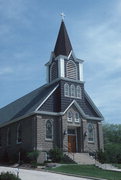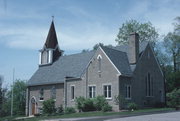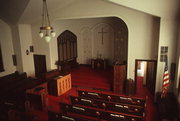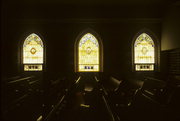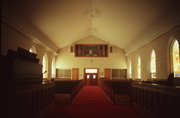| Additional Information: | A 'site file' exists for this property. It contains additional information such as correspondence, newspaper clippings, or historical information. It is a public record and may be viewed in person at the Wisconsin Historical Society, State Historic Preservation Office.
Another map code for this building is WK 46/27, found on the DOT Hartland map.
Description:
The Dansk Evangelical Luterhan Kirke, located at 400 West Capitol Drive, was built in 1910 for the Danish-speaking Lutheran congregation of Hartland. The church was dedicated on May 7, 1911. J. P. Peterson of Hartland was the contractor, and Nels Lund of Menominee Falls executed the concrete work. Built of coursed concrete block with a rock face finish in the Romanesque Revival style, the rectangular church is one tall story in height, beneath which is a raised concrete basement and above which is an asphalt gable roof. Shingles appear in the gable end. A concrete block and shingle tower rising to a height of forty feet dominates the main facade. The main entrance is located at the base of the tower, and consists of a recessed pair of wooden doors surmounted by a stained glass transom. Above the doorway is a panel inscribed "Dansk Ev. Luthe. Kirke." A pair of small pointed-arch leaded glass windows appear above the panel, surmounted by a set of three similar windows. Large Gothic-arched leaded glass windows flank the tower, and continue the lenght of the east and west facades. A non-contributing concrete block addition constructed in 1951 appears on the rear facade, east of three leaded glass lancet windows. On the interior the simplicity of the nave and chancel contrast with the ornate stained glass windows which line the walls of the nave and appear at the chancel end behind the main altar. Ceiling fans provide air circulation.
Architectural/Engineering Significance:
The Dansk Kirke is architecturally significant as a good local example of Romanesque influenced church architecture. Its architecutral integrity is uncompromised by the addition, which is unobtrusive, constructed on the rear of the building of matching scale and materials. Known as the Lake Country Congregational Church since 1975, the Dansk Kirke is one of three churches being nominated to the National Register. The Zion Evangelical Lutheran Church (403 West Capitol Drive, 1910) and the First Congregational Church (214 East Capitol Drive, 1923) are both examples of the Neo-Gothic tradition of church architecutre; the Dansk Kirke is the only Romanesque-influenced church in Hartland.
Historical Background:
Danish immigration to the United States began in the 1830s, greatly increasing in the 1840s and 1850s. Many Danes settled in Wisconsin, entering the state in Racine. From there, the Danes spread out into the state, many untimately moving to and settling in Minnesota. The first Dane in the Hartland area was Laurits Jacob Fribert. He lived in New Upsala, the Swedish settlement of Gustaf Unonious on Pine Lake. In 1847, he wrote the first book describing the United States to his countrymen, "Manual for Immigrants to the American West," thus greatly stimulating immigration. Laurits later moved to Ashippun. (See Bib. Ref. A, B, F).
Another early Dane was Ludvig Christiansen. Unlike those moving through Racine, he came to Wisconsin from New Orleans, arriving in Hartland in 1845-1846. The village's greatest influx of Danes arrived between 1855 and 1861. The area became "one of the first decidedly Danish setlements ... in Waukesha County." Evidence of the heavy concentration of Danes is found in the 1867 founding of the Danish Lutheran congregation, one of the state's earliest outside of Racine.
On May 5, 1867, an organizational meeting was held at the house of Jacob Blitsch. "We, the undersigned," the group at the meeting resolved,
"having had under condsideration the propriety of building
a Lutheran Church in or about the Village of Hartland,
and having come to the conclusion that it would advance
religion and Christian life; furthermore, that it would
advance the interest of the village itself; therefore, we
invite all and everyone, without distinction of creed or
sect, to help us by contribution (of) as much as possible.
Any amount will be thankfully received. The regular service
will be held in the English language, but should it be
desired to have it held in the German, or Danish, it may
be done before or after the service is over." (See Bib. Ref. G).
A month later the group had received a three acre lot on Oconomowoc Street from a Mr. Middlewood and had enough money to build their church. On January 12, 1868, the joint Danish/German congregation held the first service in their new building. (See Bib. Ref. C, G).
The Danish and German congregations split in 1910 with the Danes buying out the German share of the church. The old building was demolished and a new one built later that year. Ethnic identity was strong at the church. Half of the services were preached in the native language in 1918. This practice continued to 1931. In 1922, the congregation affiliated with the United Danish Evangelical Lutheran Church; a group that was later absorbed by the American Lutheran Church. (See Bib. Ref. C, D, E).
Historical Significance:
Although the present building replaced the original structure in 1910, it is significant under criterion A as the last tangible reminder of a once thriving Danish community in Hartland. |
|---|
| Bibliographic References: | A. Christensen, Thomas P. "Danish Settlement in Wisconsin." Wisconsin Magazine of History XII: 19-40.
B. Hale, Frederick. Danes in Wisconsin. Madison: State Historical Society of Wisconsin, 1981.
C. Hartland History Group. Hartland: A Chronicle 1838-1976. Hartland: 1976.
D. Hartland News, 12/07/1918.
E. Porter, H. Boone. "The Religious History of Waukesha County." In From Farmland to Freeways: A History of Waukesha County Wisconsin, edited by Ellen D. Langill and Jean Penn Loerke. Waukesha: Waukesha County Historical Society, Inc., 1984.
F. Stark, William. Pine Lake. Chenequa: 1984.
G. Weed, Nellie Warren. The Hartland Story. History File. Hartland Public Library, Hartland, Wisconsin.
H. Hartland News, 08/20/1910; Hartland News, 05/06/1911; Hartland History Group, Hartland: A Chronicle, (Hartland, WI: 1976), p. 45.
I. "HISTORIC WALKING TOUR OF HARTLAND", BY PAMELA WEINHAMMER, 1992.
J. HARTLAND LAKE COUNTRY REPORTER 5/5/1994.
K. Date of construction source: Cornerstone. |
|---|

